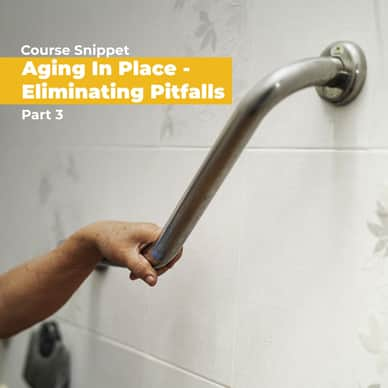Aging in Place: Part 3 | 4 HSW Credits
Published on December 30, 2019 by Sara Chauvette

Below is the 3rd snippet from the online narrated course, Aging in Place - Eliminating Pitfalls. This course is AIA Approved for 4 HSW credits.
PROBLEMS TO BE EXPECTED WITH AGING
We have a long history of aging, pretty much since the beginning of time. It is no longer difficult to predict what will happen in our lives and bodies as we add to our years.
Balance will become a significant issue. This problem can arise from a loss of physical strength, effects of different medications, cognitive and visual impairments. Without thinking through a strategy to prevent or at least minimize falls, an issue with balance can become a significant health hazard. It's a really good idea to periodically determine if loved ones (or you) can safely do these:
- Climb up and down stairs with confidence
- Stand and sit down again on chairs, beds, toilets, etc.
- Get into, bathe and safely exit bathtubs and showers
- Drive and return from destinations, from a standpoint of both physical and cognitive capability
- Bend down and pick up items from the floor or lower shelves
- Easily carry items like grocery bags and laundry baskets
- Successfully use public transportation
- Keep the home and property clean
- Properly use all appliances
- Manage personal health
A consequence of deciding to stay at home, whether alone or not, is the strong possibility of home accidents. Depending on the severity of the accident and whether injuries occur, if someone falls, they may not be able to get back on their feet. Cognitive issues like dementia can lead them away, but not necessarily back home. Extended periods of solitude, especially around holidays and in periods of inclement weather, can foster feelings of depression. In the presence of confusion and absence of assistance, medication use can turn dangerous when ignored, taken in excess or inadvertently combined with other medicine. Limited mobility leads to other issues like avoiding grocery shopping or failure to make scheduled health appointments. There are also various health conditions like strokes or Parkinson's disease where the victims can simply no longer function alone.
Even if your loved one will allow you to make changes, it's a very good idea to ease into them gradually. Prioritize the changes you (and they) feel will be beneficial and set a time frame to implement them. Discuss options and let the resident choose which ones will best meet their needs. Then accomplish agreed upon tasks in portions. Give those you love a chance to adapt to a few changes, before the next set is implemented. If all that sounds like it will be easy, it won't.
Learn More in Part 4.
